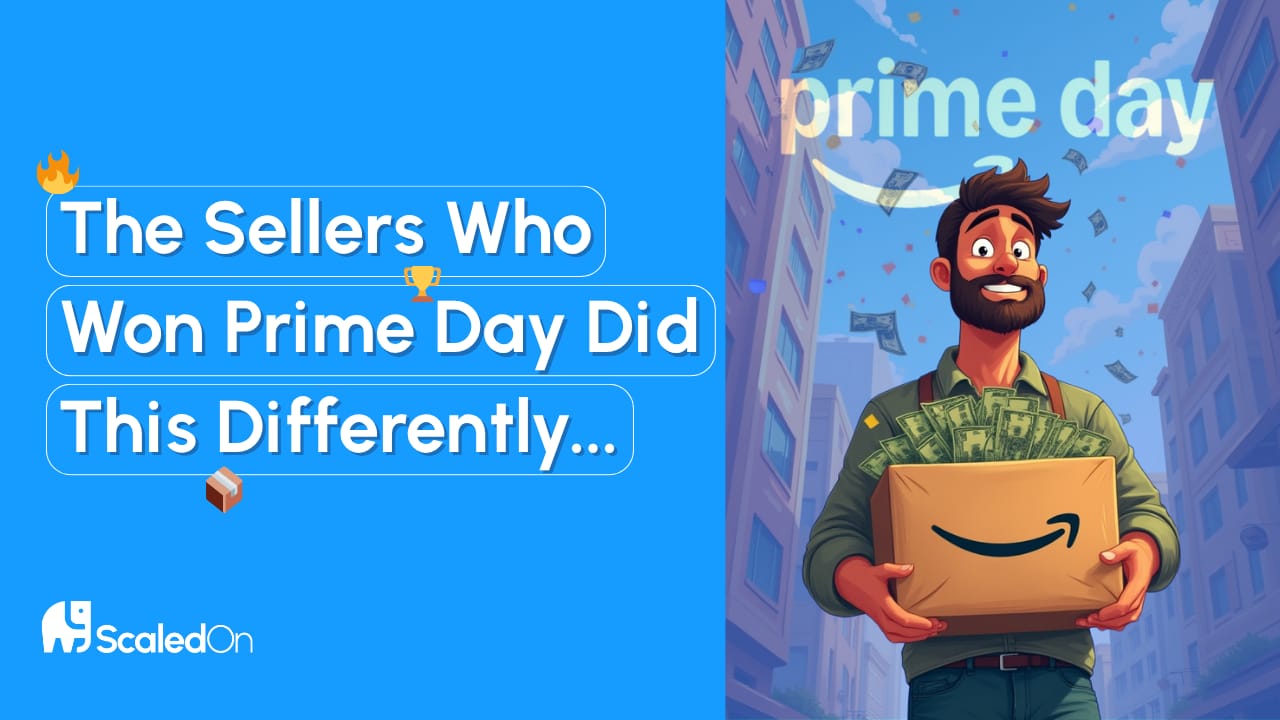Hey, 👋
After seeing the results our team delivered on Amazon, it felt only right to hit pause on AI and unpack what just happened on Amazon Prime Day.
🎯 Quick Insight:
Prime Day isn’t a sprint anymore…it’s a test of strategic stamina.
Amazon quietly turned Prime Day into a 4-day event, this isn’t a one-off. It’s the new standard.
The sellers who prepped like it was still 2024?
They burned out by Day 2.
The ones who paced, planned, and played the NEW game?
They won.
🧠 Deep Dive: Prime Day 2025 Results & Lessons
🔥 80.7% YOY sales growth across our client portfolio.
💰 Most of the clients hit all-time sales records.
📉 Sellers without a 4-day game plan? Burned budget and lost visibility.
Here’s what worked and what really didn’t…


✅ The Strategic Lessons That Mattered
The Discount Plan That Actually Worked
Prime Event Price Discounts, particularly those at 30%, dominated consistently, outperforming everything else.
20% Prime Day Price Discount came second, followed by coupons, which enhanced visibility, then strike-through pricing. Sellers who tried to preserve margins with minimal discounts found themselves watching competitors capture the traffic they should have owned.
Prime Day operates on different economics where aggressive discounting unlocks algorithmic advantages.
👉 Prime Day is about velocity, not margin.
Ads Backup Strategy That Prevented Disaster
One of the most critical lessons was the importance of pre-event backups. Sellers who documented their profitable settings before making Prime Day changes could quickly revert post-event, thereby avoiding the typical weekend performance crash that often plagues many sellers after major promotional periods.
This operational discipline saved one client from a post-Prime Day disaster when their ACOS spiked 300% on Saturday morning. A quick backup had them back to profitable operations within hours instead of days.
Budget Endurance: The Long Game
Day 4 of Prime Day revealed the power of strategic budget allocation. While many sellers front-loaded their spending in Days 1-2, those who reserved budget for the later days captured significant performance advantages when competitors were tapping out.
👉 Day 4 = The Goldmine: We saw accounts that maintained budget discipline achieve 33% performance increases on Day 4 alone. The extended format rewards patience and planning over reactive spending, as Amazon's data shows that Day 4 had some of the highest conversion rates, but only for sellers with inventory and budget remaining.
FBA Was the Real MVP
FBA accounts grew 81% YOY vs. just 22% for FBM.
FBA sellers consistently outperformed FBM sellers across every category we managed. This wasn't marginal, it was substantial. Amazon's logistics network, particularly during peak traffic periods, provides a competitive advantage that independent fulfillment services simply can't match.
The difference was stark: FBA accounts in our portfolio averaged 81% growth year-over-year, while FBM accounts averaged just 22%. For sellers still undecided about FBA, Prime Day 2025 provided a clear case study in the value of Amazon's infrastructure during high-stakes periods.
🚫 What DIDN’T Work
1. External Traffic: Not the Lever You'd Expect
Pushing additional external traffic on event days showed minimal incremental impact across our portfolio. Amazon was already spending massive amounts on platform-wide advertising, creating a high-traffic environment where additional external sources didn't provide the usual lift.
External traffic campaigns, which typically drive strong results, saw diminished returns during the event days.
The lesson: During major Amazon events, external traffic isn't a bad strategy, but it's not the primary lever for success. Focus your optimization efforts on within-ecosystem strategies where the real Prime Day advantages lie.
2. Real-Time Optimization: The Patience Test
Amazon's reporting delays and fluctuating CPCs during the event made real-time optimization more challenging than in the previous years. Sellers who over-optimized based on delayed data often made decisions that negatively impacted performance once attribution data caught up.
We observed that accounts that resisted the urge to make knee-jerk adjustments significantly outperformed those that reacted to early data. One client who maintained their strategy despite Day 2 reports showing concerning metrics ultimately achieved their strongest Prime Day performance ever once the full attribution picture emerged 48 hours later.
🔧 What’s Next: The Fixes
The sales spike is behind us, but for many sellers, Prime Day left behind some quiet chaos.
Here’s what we’re seeing across accounts:
⚠️ Account health metrics dipping without a clear reason
🚫 ASINs getting flagged or quietly suppressed
🐛 Backend errors surfacing, most with zero alerts from Amazon
🕵️♂️ Suspensions hitting without warning or obvious cause
These aren’t one-off issues. They’re signals that your account infrastructure may not be ready for Q4’s pressure.
That’s why we’ve launched our Prime Day Recovery Plan a fast-track system to:
Run a full account health diagnostic
Reinstate flagged ASINs and remove risk triggers
Uncover and fix backend issues before they tank visibility
Rebuild stability before peak season hits
👉 Book Your Own Recovery Plan Here.
Turn Prime Day momentum into Q4 scale, NOT support tickets.
💬 My Final Thoughts
Prime Day 2025 was more than a four-day sales event, it was a shift in Amazon's rewards strategy.
The sellers who won weren’t just ‘lucky’. They played the long game: prepped early, paced their budgets, and stayed disciplined. That marathon mindset is now the baseline.
And it’s working. Our top accounts are already up 7% post-event, proving that the right strategy doesn’t just win the promo - it builds lasting momentum.
The sprint is over. Success now belongs to those who can endure it.
As we head into Q4, remember: your promos are only as strong as the systems behind them.
Let’s scale smarter,
— Iulia



